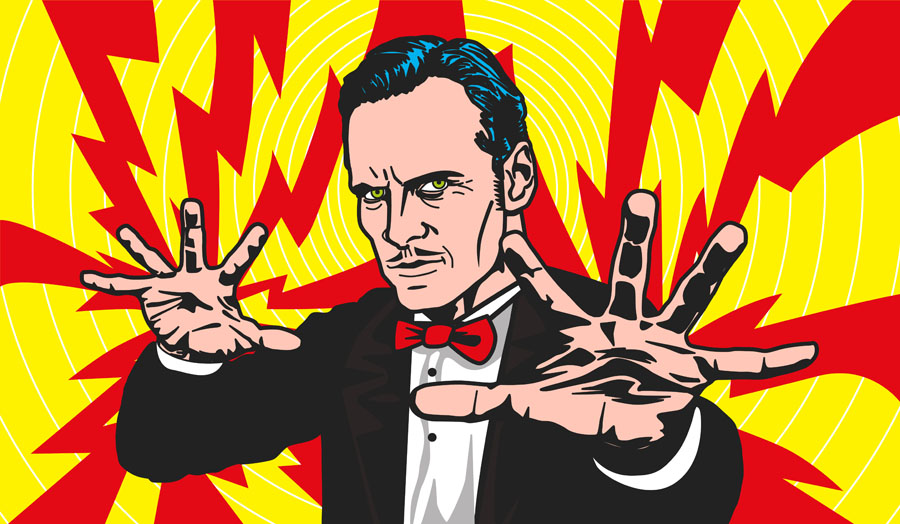

“The mini-com classes” were started by Dr Emmanuel Tourpe on his Facebook feed during the coronavirus crisis. His publications met with an inevitable success (dare I say virality?) which led me to propose him the project to make them available to all on our blog. Thanks to him for accepting. Let’s remind you that Emmanuel, as well as being a renowned academic, is also Arte’s director of programming. An exceptional man, wearing several hats, one might say.
In the mini-com course n°5, modestly entitled “The podium of the three tricks that work best for communicating” :-), he gives us some handy tips to communicate more effectively.
Find other “Mini-com courses” here: #1, #2, #3, #4.
Mini-com course n°5
The top 3 things that work best for communication
I’ll save you years of marketing research and reveal the King’s Secret. The XXXIInd level of Freemasonry. Everything Tom Cruise learned in Scientology. The Mysterium Magnum: the communication strategies that work best! Don’t forget the guide at the end, if you please!
Drum roll, Marseillaise or Brabançonne… Watch out, here is the bronze medal!

TOP 3: “Stand out from the crowd and inspire people to come back.”
Seriously now, I’m saving you thousands of euros because what I’m going to write now can sometimes be very expensive when you bring in a consultant to say it.
The art of communication is first of all the skill of GETTING THE ATTENTION: it sounds banal, but in reality, very few people think about it. Is the person or the group I’m talking to in a position to receive the message? Is this the right place? Is it the right way? Don’t focus on my desire to “unleash” my idea, but first check that I can simply get the attention I need. Then, I need a “hook” that can be visual, sound, image… my message has to stand out from the crowd. Cognitive psychology shows, for example, that a picture with a human being, especially his eyes, attracts more attention than an image of an object. It is not for nothing that car manufacturers so often associate young women with the models they want to sell. Attention must be diverted and attracted. A silly press conference when you have something important to say is not enough: you have to dramatize, create the event, a “break” that makes a statement. I have a trick when I want my teenagers to look up from their cell phones. I yell that we’re going to talk about their allowance ?

Then you have to KEEP THE ATTENTION: that’s what com pros call “loyalty”: regularly refresh what you put on your Facebook or Instagram account, for example. Guarantee a “promise”: my interlocutors know exactly what they can expect from my message. For example, you can imagine that if all of a sudden, I start programming low-end big American comedies on Arte, I’m not fulfilling Arte’s promise of quality and I’m confusing the message. You have to put yourself in the other person’s shoes, once again, and ask yourself what benefit, gain or pleasure he or she will find in continuing to read me, listen to me or watch me. This is true for any business: why should anyone continue to listen to me?

TOP 2: Tell, tell, tell
We are advanced prehistoric men. We grew up by the fire. We’ve been feeding off the stories that were told there for 30,000 years. We are made for stories. This explains our immoderate taste for series and films. The invention of the “concept” and abstract thought is quite recent (5th century BC). Nothing suits us better, even to understand slightly complicated things than a story. If I were a maths teacher, I would tell the story of concepts: for example, why all of a sudden, a certain Leibniz discovered a great tool called “differential calculus” and the incredible innovation it was, like the fantastic services it renders.

In philosophy, I always tell the life of thinkers at the same time as their thoughts, because the root of ideas is in life and great stories. The pros call it “story-telling”: telling a good story. It’s quite recent that com has understood this, barely twenty years ago. So, com’s number two rule became Hitchcock’s famous answer when asked what makes a good movie: “A good story. But also, a good story. And finally, a good story.” So, tell it instead of just putting it out there. When you talk, use intonation, drama: take your interlocutors towards suspense, enthusiasm, ups and downs that tell them your idea.

TOP 1: to communicate is to love
In a TV debate, the winner is always the one who stays calm, stayed positive. The loser is the one who gets angry, who attacks – even when he is right. A smile does infinitely more for a successful comedy than a good idea. It’s not enough to be right about what you want to say. That’s the great misunderstanding of comedy: you think you’re saying what’s correct and rational to the other person. When in fact THE COM HAS VERY LITTLE TO DO WITH REASON. More precisely, it is a trick of reason: communicating is not demonstrating.
Start a text message or an email with a dry “Hi” or “Sir” you’ve already missed half your comms. You haven’t taken care of each other or shown your kindness. Do you want to make a criticism? Start by saying what good the other one did. That will set your mind straight, by the way.

You can only communicate well by being on the other’s turf by seriously facing the other person. A message must touch not only the mind but also the heart. That is why the queen of communication is the communion of souls. Accurate and successful communication takes place only within a loving dialogue, where each person questions himself or herself out of love and addresses his or her message only in love. To communicate is, first of all, to love – and there is successful communication only in love. This law can explain even the great rules of non-violent communication.
Any other form of communication lags behind this TOP 1, which is the magisterial summit and the great secret that very few know: one communicates only in love. And conversely (all couples know it) we only love by relating.
For further information
Illustrations : shutterstock
Posted in Misc..

